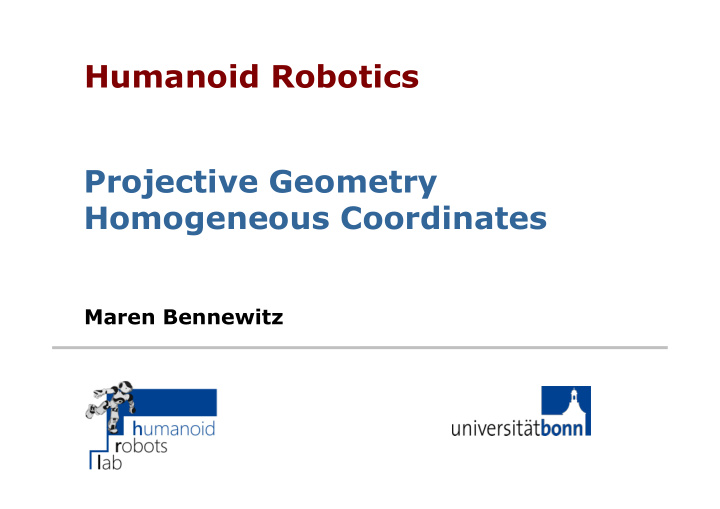



Humanoid Robotics Projective Geometry Homogeneous Coordinates Maren Bennewitz
Motivation § Cameras generate a projected image of the world § In Euclidian geometry, the math can get difficult § Projective geometry is an alternative algebraic representation of geometric objects and transformations § Homogeneous coordinates are often used in robotics for the sake of simplicity § All affine transformations and even projective transformations can be expressed with one matrix multiplication
Pinhole Camera Model § Describes the projection of a 3D world point into the camera image § A box with an infinitesimal small hole § The camera center is the intersection point of the rays (pinhole) § The back wall is the image plane § The distance between the camera center and image plane is the camera constant
Pinhole Camera Model image plane camera center (pinhole) object camera constant (focal length)
Geometry and Images Image courtesy: Förstner
Pinhole Camera Properties § Line-preserving: straight lines are mapped to straight lines § Not length-preserving: size of objects is inverse proportional to the distance § Not angle-preserving: Angles between lines change
Information Loss Caused by the Projection of the Camera § A camera projects from 3D to 2D § This causes a loss of information § 3D information can only be recovered if additional information is available
Information Loss Caused by the Projection of the Camera § A camera projects from 3D to 2D § This causes a loss of information § 3D information can only be recovered if additional information is available § Multiple images § Details about the camera § Background knowledge § Known size of objects § …
Homogeneous Coordinates § H.C. are a system of coordinates used in projective geometry § Formulas using H.C. are often simpler than using Euclidian coordinates § Points at infinity can be represented using finite coordinates § A single matrix can represent affine and projective transformations
Notation Point (or or ) § in homogeneous coordinates § in Euclidian coordinates 2D vs. 3D space § lowercase = 2D § capitalized = 3D
Homogeneous Coordinates Definition § The representation of a geometric object is homogeneous if and represent the same object for Example homogeneous Euclidian
Homogeneous Coordinates § H.C. use a n+1 dimensional vector to represent the same (n-dim.) point § Example:
Definition § Homogeneous Coordinates of a point in the plane is a 3-dim. vector § Corresponding to Euclidian coordinates
From Homogeneous to Euclidian Coordinates
From Homogeneous to Euclidian Coordinates Image courtesy: Förstner
3D Points § Analogous for 3D points in Euclidian space homogeneous Euclidian
Origin of the Euclidian Coordinate System in H.C.
Points at Infinity § It is possible to explicitly model infinitively distant points with finite coordinates § H.C. allow us to maintain the direction to that infinitively distant point
Transformations § A projective transformation is an invertible linear mapping § Called homography
Important 3D Transformations § Projective mapping § Translation: 3 parameters (3 translations)
Important 3D Transformations § Rotation: 3 parameters (3 rotation) rotation matrix
Reminder Rotation Matrices § 2D: § 3D:
Important 3D Transformations § Rotation: 3 parameters (3 rotation) § Rigid body transformation: 6 params (3 translation + 3 rotation)
Important 3D Transformations § Similarity transformation: 7 params (3 trans + 3 rot + 1 scale) § Affine transformation: 12 parameters (3 trans + 3 rot + 3 scale + 3 sheer)
Important 3D Transformations § Projective transformation: 15 params (affine transformation + 3 parameters) § These 3 parameters are the projective that yield to the fact that parallel lines may not stay parallel
Transformations for 2D Image courtesy: Schindler
Transformations Hierarchy (2D/3D) projective transformation (8/15 parameters) affine transformation (6/12 parameters) similarity transformation (4/7 parameters) motion transformation (3/6 parameters) rotation translation (2/3 parameters) (1/3 parameters)
Example: Homography source: openMVG
Inverting and Chaining § Inverting a transformation § Chaining transformations via matrix products (not commutative)
Conclusion § Homogeneous coordinates are an alternative representation for transforms § Can simplify mathematical expressions § Can model points at infinity § Allow for easy chaining and inversion of transformations § Modeled through an extra dimension § Equivalence up to scale
Literature § Multiple View Geometry in Computer Vision, R. Hartley and A. Zisserman, Ch. 2, 3 § Slides based on Chapter 15 “Projective Geometry (Homogeneous Coordinates)”, Photogrammetry I by C. Stachniss
Recommend
More recommend